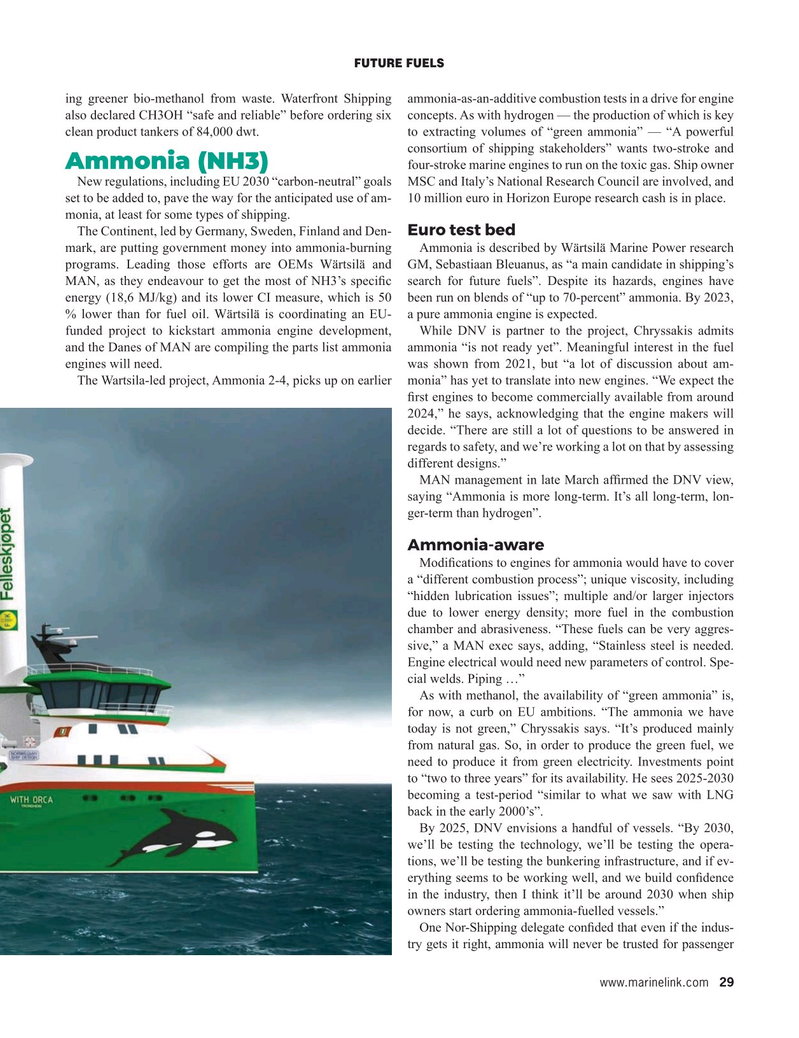
Page 29: of Maritime Reporter Magazine (May 2022)
Green Ship Technologies
Read this page in Pdf, Flash or Html5 edition of May 2022 Maritime Reporter Magazine
FUTURE FUELS ing greener bio-methanol from waste. Waterfront Shipping ammonia-as-an-additive combustion tests in a drive for engine also declared CH3OH “safe and reliable” before ordering six concepts. As with hydrogen — the production of which is key clean product tankers of 84,000 dwt. to extracting volumes of “green ammonia” — “A powerful consortium of shipping stakeholders” wants two-stroke and
Ammonia (NH3) four-stroke marine engines to run on the toxic gas. Ship owner
New regulations, including EU 2030 “carbon-neutral” goals MSC and Italy’s National Research Council are involved, and set to be added to, pave the way for the anticipated use of am- 10 million euro in Horizon Europe research cash is in place. monia, at least for some types of shipping.
The Continent, led by Germany, Sweden, Finland and Den- Euro test bed mark, are putting government money into ammonia-burning Ammonia is described by Wärtsilä Marine Power research programs. Leading those efforts are OEMs Wärtsilä and GM, Sebastiaan Bleuanus, as “a main candidate in shipping’s
MAN, as they endeavour to get the most of NH3’s speci? c search for future fuels”. Despite its hazards, engines have energy (18,6 MJ/kg) and its lower CI measure, which is 50 been run on blends of “up to 70-percent” ammonia. By 2023, % lower than for fuel oil. Wärtsilä is coordinating an EU- a pure ammonia engine is expected. funded project to kickstart ammonia engine development, While DNV is partner to the project, Chryssakis admits and the Danes of MAN are compiling the parts list ammonia ammonia “is not ready yet”. Meaningful interest in the fuel engines will need. was shown from 2021, but “a lot of discussion about am-
The Wartsila-led project, Ammonia 2-4, picks up on earlier monia” has yet to translate into new engines. “We expect the ? rst engines to become commercially available from around 2024,” he says, acknowledging that the engine makers will decide. “There are still a lot of questions to be answered in regards to safety, and we’re working a lot on that by assessing different designs.”
MAN management in late March af? rmed the DNV view, saying “Ammonia is more long-term. It’s all long-term, lon- ger-term than hydrogen”.
Ammonia-aware
Modi? cations to engines for ammonia would have to cover a “different combustion process”; unique viscosity, including “hidden lubrication issues”; multiple and/or larger injectors due to lower energy density; more fuel in the combustion chamber and abrasiveness. “These fuels can be very aggres- sive,” a MAN exec says, adding, “Stainless steel is needed.
Engine electrical would need new parameters of control. Spe- cial welds. Piping …”
As with methanol, the availability of “green ammonia” is, for now, a curb on EU ambitions. “The ammonia we have today is not green,” Chryssakis says. “It’s produced mainly from natural gas. So, in order to produce the green fuel, we need to produce it from green electricity. Investments point to “two to three years” for its availability. He sees 2025-2030 becoming a test-period “similar to what we saw with LNG back in the early 2000’s”.
By 2025, DNV envisions a handful of vessels. “By 2030, we’ll be testing the technology, we’ll be testing the opera- tions, we’ll be testing the bunkering infrastructure, and if ev- erything seems to be working well, and we build con? dence in the industry, then I think it’ll be around 2030 when ship owners start ordering ammonia-fuelled vessels.”
One Nor-Shipping delegate con? ded that even if the indus- try gets it right, ammonia will never be trusted for passenger www.marinelink.com 29
MR #5 (18-33).indd 29 5/3/2022 9:18:04 AM

 28
28

 30
30
